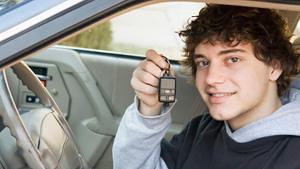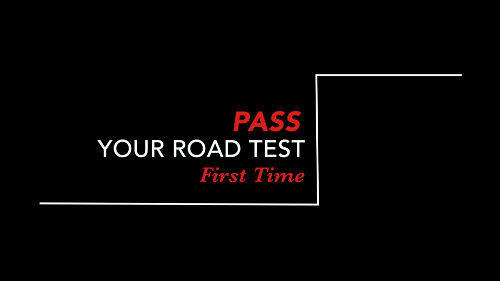Learn how to judge the gap to both change lanes and pass a driving test - watch the video!
How to Change Lanes & Judge a Safe Gap to Pass A Road Test
Closed Caption
Summary• Mirror, signal, shoulder check in preparation of changing lanes; • Minimum 3 flashes on the signal before moving over; - one flash to get the other driver's attention - two flashes for the other driver to locate you - three flashes for the other driver to take action • Mirror, shoulder check again before moving the vehicle laterally; • Accelerate slightly as you move between lanes to maintain speed because you are covering more ground; • leave your signal on until you're completely in the next lane; • Cancel signal and continue. • If you are changing more than 1 lane, leave your signal on and pause in every lane before moving to the next; • Other drivers will most often help you out, but only if you asked via your turn signal. |
Introduction
Hi there Smart drivers. Rick with Smart Drive Test, talking to you today about: How to change lanes, how to judge the gap, and how to do all of that safely. Stick around, we'll be right back with that information.
[INTRO AND MUSIC]
Rick with Smart Drive Test, talking to you about: Lane changes, determining appropriate gap, and doing that safely.
Now, if you're working towards a license, or starting your career as a truck or bus driver, be sure to hit that subscribe button... right about there.
As well, hit that bell. That way you'll get instant notification when I get the videos up for you.
Now for a lot of new drivers, I think when they put their signal on, what happens, is they get anxious and they feel like they need to move over right away.

No, you need minimum three flashes on the signal before you start moving over.
And whether you're working towards a license or you already have a license, make sure that you shoulder check minimum two times before you start moving that vehicle over.
Fear & Trepidation Surrounding Lane Changes & Merging
I think a lot of drivers get into trouble, because they stopped shoulder checking, and then they start to move over and they get honked at, because there's a vehicle in the blind spot that they didn't see before they started moving over, because they didn't observe correctly.
So know that you got time. Just relax. Three flashes on the signal, head check.
Head check before, and head check after. And then, start moving over. So what we're gonna do here, we're gonna hook up the cameras, going to go for a drive in the car, and we're going to show you how to change lanes, how to determine if the gap is safe, and show you that if you communicate effectively with other drivers that they will help you out the lane change.
Because, driving is a social activity, and it takes everybody to work together to be able to do it safely. So, let's hook up the cameras, and go for a drive.
Hi there Smart Drivers, welcome back.
Rick with Smart Drive Test, talking to you today about: Gap, and how to judge the gap when you're looking in the mirror to change lanes.
Because, this is something that a lot of Smart Drivers have had requests for - Big$MoneyBoss, and others - have requested this video, to know how, and when to change lanes, to know whether the gap is large enough for them to be able to move over.
Now, one of the things that Smart Drivers and new drivers do, that causes them grief, is first of all they don't signal early enough.
You need minimum three flashes on the signal, before you start to move over to the other lane of traffic.
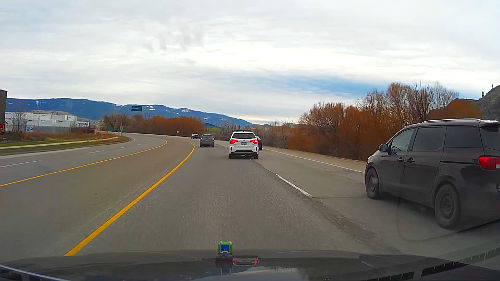
You need one blinker to get their attention. Two for them to locate you.
The third one for the other driver to take some sort of action to accommodate you, and help you to make that gap.
So, that's the first thing, is to communicate effectively by having minimum three flashes on the signal. And you can see, there's a vehicle coming up there behind me, it's the jeep.
And, we'll just get through the intersection here, scanning the intersection well.
And, you can see the Jeep is right beside me now, so there's no way that I could change lanes. And, we're not going to change lanes, because there's a big truck in front of us here.
Get Past Larger Vehicles Quickly
Actually, it's the driving school truck is right here, and we're not going to hang out beside him too long, we're just going to zoom right up past this truck here.
Never hang out behind beside large vehicles, because they have large blind spots, and they may or may not be able to see you, so just get by them as quickly as you can.
We'll get up here on the other side of the intersection, and then we'll change lanes. And we're gonna change lanes and be in front of that big truck.
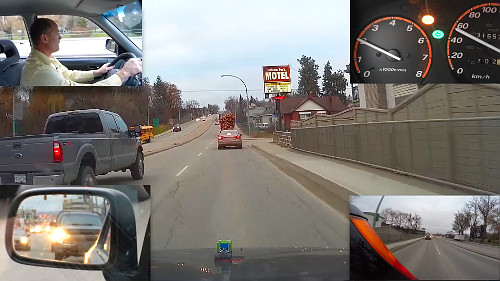
But, we're not going to put our signal on until we get on the other side of the intersection, so as not to confuse other drivers.
Okay, and you saw that vehicle in front there, he changed lanes.
So I've had minimum three.
And, I think what happens is with new drivers as well, is they want to change lanes, and then they get anxious.
As soon as they put their signal on, they think "Oh my god I got to change lanes right away!"
You've got lots of time to change lanes. So, put your signal on, wait three flashes, check, and then immediately before going again, check again.
And head check twice before you go over, and leave your signal on all the way until you're in the other lane.
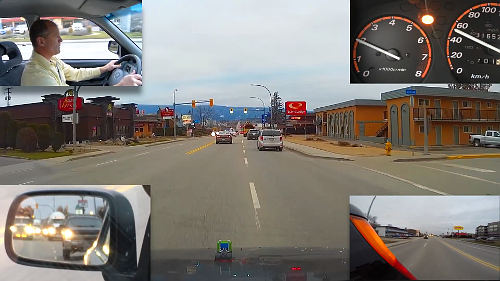
And again, I'm going to change lanes back. So, signal, three, head check, shoulder check again, leaving the signal on all the way across, until we're in the other lane of traffic.
Okay, and now we're going to change back, one, two, three, shoulder check twice, signals on all the way across here.
Leaving my signal on, because I'm going to get into the turning lane, and I'm going to turn left here, so just leave my signal on all the way.
Stopping At the Correct Position in Traffic
And I come up, until I can I can see the tires of the vehicle in front of me making clear contact with the pavement.
And, know for the purposes of a driver's test, it's not you that can see the tires making clear contact with the pavement, but rather it's the examiner sitting over there.
So, if the examiner is really short or really tall, you want to compensate for that a little bit.
Especially if they're a little bit short, you want to stay back a little bit farther, for the examiner to be able to see the tires making clear contact with the pavement.

You can see here, the vehicles have moved up a little bit, but I'm just going to stay right where I am.
Because, you don't want to creep on a road test, for the purposes of a road test.
As well, I'm working really hard to keep my hands bolted to the steering wheel, for the purposes of this exercise.
So, lights not changing yet. You can see there's a pedestrian in the crosswalk, so you know that it's a fresh green, and it's not going to change anytime soon.
You always want to be monitoring the other light while you're sitting here, and monitoring the intersection.
That way, it'll give you some indication when the light is about to change.
And, both of the pedestrians have crossed the intersection now, so it's going to be a few more moments, and then the lights going to change.
|
LEARN THE SECRETS THAT DRIVING SCHOOLS DON'T TELL YOU!• FEAR :: Know that you WON'T have to face friends & family and tell them you didn't pass;• SELF-CONFIDENCE :: Get the exact skills from a licensed driving instructor that will guarantee your success;• CONFUSION :: Cut through the conflicting driving procedures information;• QUALIFIED :: Smart Drive Test has helped 1000s pass their driver's test...and we can help you! |
Traffic Cues that the Light is Going to Change
But, you can see that the traffic hasn't slowed down, or come to a stop on the cross roads yet.
So, they're coming through, the light is now going to change.
And, I've talked about, in other videos, I talked about in the crash analysis video that there's a dead space in the intersection.
Okay, into the left lane.
And, the Jeep behind me, I've communicated so that Jeep behind me, as you may or may not be able to see, has slowed down to let me move over, but the cars in front of me slowed down to turn into the mall there, so I had to slow down.
But, as long as I had my signal on behind me the Jeep behind me stayed back, because I had my signal on, and that flashing of the light indicated to that driver that I was moving over.

And, the fact that my vehicle was also half way in the other lane told that driver.
So, there were two forms of communication:
1) The position of my vehicle on the roadway;
2) and the signal flashing.
And, that light is very important. Again, we've got lights here flashing, you want to stay back a good distance.And then we just roll up to the light, right, there's other vehicles and whatnot.
And the light has turned green, we didn't even slow down on the vehicle, here.
Okay, scanning the intersection, and we want to move over. So, we wait till we get across the intersection:
Three flashes on the signal, head check, head check again immediately before moving over.
Leave our signal on until we're all the way in the other lane.
Now, I know that it's easy to lose some of the techniques and skills that you have, for the purposes of a road test, but that minimum three flashes, and good scanning for the purposes of looking, is going to keep you out of trouble, after you get your license.
Shoulder checking there before we make the left-hand turn.
Okay, and I'm in the outside lane.

Three Flashes of the Signal
Now, you can't see the other mirror.
Two, three flashes, and that vehicle has stayed back, because I've indicated that I want to move over.
So, I move over, and I regain my space in front of my vehicle, and the vehicles behind me will adjust to that.
So, I just keep a good space, two to three seconds, under ideal conditions.
And, today it's pretty good conditions for driving.
So, we're just staying back, I can see brake lights up here, I know that the light is probably going to be red at the intersection.
This vehicle is coming over, and I saw, I just caught one signal there, one flash of the signal out of the corner of my eye.
So, as soon as I saw that, I didn't want him pulling in beside me, him or her pulling in beside me, so I backed off and let them come into a space in front of me.
That way, if something went wrong, I've got space to maneuver.
So, that's a very good defensive driving strategy, is never merge in beside another vehicle, never let another vehicle merge into you.
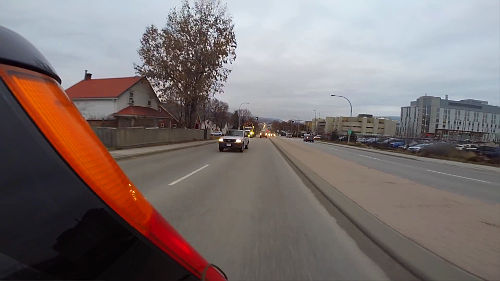
Always back off a little bit, and create a space, so that they come in front of you or behind you.
I'm just gonna move up here, because I didn't really come to a complete stop there so, so we can get as much traffic through the intersection as possible.
We want to be up, so we're one space from that vehicle in front of us, is what we were doing there.
So, again we're sitting here. And, what I was saying back at the other intersection, before I got busy doing the left-hand turn.
And, that's the other thing about when you're learning how to drive, when you're getting your license, and you're conducting complex maneuvers, like left-hand turns which are high-risk:
You don't want to be talking, unless you're talking yourself through what you're doing.
So, just be quiet, ask other people in the vehicle to be quiet, so that you can concentrate on what you're doing, and that's what happened.
And, what I was talking about was, I was talking about the dead space, one light goes to red.
There's a two-second delay from the time that your light goes red, or the other light goes red, rather, to the time yours goes green. It's called a dead space.
And, it's to prevent people from running the intersection.
So, you can see that vehicles a long way back there.
One, two, three, shoulder check, signal on, moving across, checking again as I'm halfway in the other lane, and signal off.
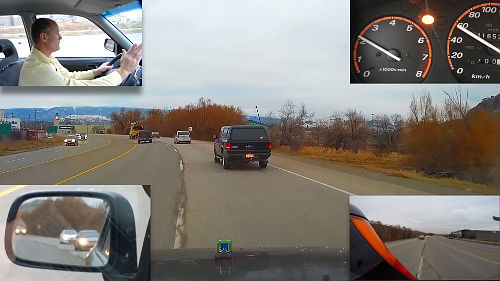
Do Not Change Lanes At Or Near Crosswalk or Intersection
And again, you can see there's a crosswalk here, and the lines went to solid white.
You do not want to cross over those solid white lines, when you're learning how to drive.
Or even otherwise, because they signify that you're usually around an intersection or a crosswalk, so you don't want to be changing lanes.
Now you see, I just crept up here, I just slowed down, I didn't come to an aggressive brake. And, the other traffic just took off, and now I just keep going.
Okay. And, I just feather the throttle, I'm in fourth gear. One, two, three, now that pickup truck let off the throttle for me to come across.
As soon as I put my signal on, and ask that driver, or indicate it to that driver that I wanted to change lanes, that driver backed off, and helped to create a gap for me to be able to move over.
So, communication, whether you're merging, changing lanes, or anytime that you're moving the vehicle laterally, is going to help you.
Because, as I've said, again and again, driving is a social event, it is a team event, we all work together.
There are rules that we follow.
And, as long as you communicate to other drivers, and you are conducting predictable actions, other drivers will help you out.
If you fail to ask, and convey your intentions, other drivers are less likely to help you out.

And, I think a lot of times. Now, see, you can see the big truck up here merging over to the right.
That truck, as soon as that truck put the signal on, to merge over to the right, the other vehicle stayed back, so that that big truck could move over.
Now, one thing I will say from my experience of driving big trucks: It's difficult to judge the space behind you, because you're 75 feet away from him or her looking in the mirror.
So, just stay back a little bit farther, and that helps the truck driver out a little bit.
But, that was really great. That truck driver put his or her signal on. As soon as he put his or her signal on, that white vehicle just stayed back, and allowed that truck to merge over to the right.
And, I'll just give you an advanced tip on trucks, that truck is loaded as you can see with the logs on it.
And, the reason that truck moved over to the right, is because there's a hill coming up here, it's Hospital Hill here in Vernon, and that trucks going to slow down on that big hill, so we're gonna get ready to move over to the left here, we're going to merge.
And, I'm just gonna let this pickup truck get passed me here, and then we're gonna move over, and we're going to watch this car in front of me.
Head check, you had to be really careful there, because that was a dangerous situation with that car turning in front of us, and we were looking to merge to the left, and that car was turning.
That's a dangerous situation, for those of you learning how to drive just keep in mind, because your attentions over there, and that cars turning in front of you.

Avoiding Slow Downs - Advanced Driving Tip
So, see the big truck is slowed down, we're passing the big truck.
There's an advanced driving tip for you, we're not going to move back, because there's a crosswalk and a solid white line here.
But, now we're gonna move back.
Three flashes on the signal, and I got some yuck in a pickup truck, who's just coming to beat the band, got to be first.
Okay, so now it's clear.
And, if it's like that, you see that car screaming up there, as you may or may not have seen in the cameras, then just let that person go past you, and then move over.
But, leave your signal on, that way they're gonna get freaked out that you might move over, but if you leave your signal on, it tells them to hurry up.
Now, I'm speeding here, because this is still a 50 km/h speed limit, here in Vernon, so that's bad.
Now, I can't see my camera, because, or I can't see my speedometer, rather, because my camera is in front of the speedometer.

Lane Changes on the Highway
But, now I'm doing 50, you can see the other vehicles are passing me, because this is really going out onto the highway, it really shouldn't be 50 here, it should be 70.
But, I'm slowing down to 50 here. I'm going to go out on the highway. I'm going to do a couple of merges out on the highway.
And, now you can see it goes up to 70 here, and now I can just see my speedometer in the camera that's sitting in front of my speedometer here.
So, we also see up here, that we have a truck pulled over on the side of the road. If you see that then, and you can, it's safe to move over to the other lane.
So, I'm going to move over, three flashes on the signal. Now, that vehicle is fairly far off the road, so I'm just going to go right back over.
But, you don't know what that person is doing, okay.
So, now it goes to 90 here, and just gonna go 70.

And you can see that truck right beside, me is right up beside me.
Okay, so now we're up, we're attaining the speed limit as quickly as possible, so we're up to 90.
You can see that there's, that white truck there, there's probably enough room for me to pull over beside that truck.
So, I'm just keeping my eye on the green light here, in case it turns on me, but I don't think it's going to, I think I'm gonna be all right.
So, that truck didn't come up and pass, because that truck turned there, left, at that intersection, where the Okanagan College's here in Vernon.
So, of course I'm, because I was driving the speed limit, now I'm behind the gaggle. And, because I'm behind the gaggle, it's not going to work out for me changing lanes.
Now, there's a red van coming up behind me here, and because I'm doing the speed limit, that van is probably going to come up fairly quickly here, and pass my vehicle.
Now, you can see, now I don't know whether you can see in the camera there, but that vehicle is just screaming past me, he or she's probably doing 110.
Okay, so that wouldn't be safe.
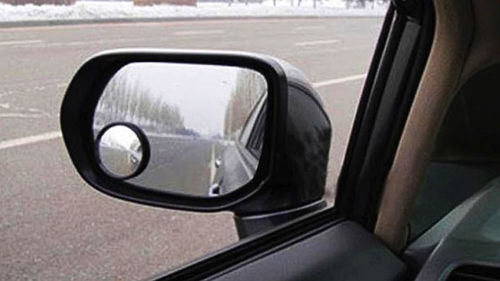
And, it's the same thing out here on the highway, there's not any traffic around me right now, but we're going to catch up here on the hill.
And, I'm speeding a little bit. I just take my foot off the throttle, and get it adjusted back down again.
Okay, coming back out on the highway here, and we want to move over to the right lane, but we want to get up to speed, we don't want to pull out in front of somebody.
So, it's better to stay in this lane, and get it up to speed, okay.
Technique for Other Driver's Inappropriate Actions
Pickup truck is coming up there, and I'm doing 90, and I'm just going to wait for that truck to come pass me.
The truck has passed me, I've got my signal on, the other vehicle moved over to the left, to get past me.
And, now you can see the other vehicle coming up there, and going past, and that vehicle is probably doing 110, that's why I'm not moving out into the other lane.
Now, it's unlikely that you're going to have to change lanes on a highway, if you're doing your road test, because you're going to be doing the speed limit, and most of the other vehicles are going to be passing you.
So, you want to stay in the right lane.
And, of course, for the purposes of a road test, because you're doing the speed limit, you're gonna have to stay in the right lane for the most, majority of your test anyway.
Unless the examiner tells you to turn left at an intersection, you're going to stay in the right lane.
And, as soon as you make a left-hand turn, you're going to move back over to the right-hand lane.
So, what I'm gonna do here is, there's some traffic coming up behind me here, and I'm just gonna speed up a little bit.
Don't do this for the purpose of your road test, this is for drivers who've gotten their license.
And then, I'm going to show you how to merge over on the highway, because I know that for new drivers who've just gotten their license, this tends to be a bit more intimidating out on the highway, because they're traveling at such speed.
Now, I'm doing 100, there's a pickup truck coming up there. And, this is the other thing about being out on the highway, when I talk about this with cruise control.

Just set your speed on your cruise control a few kilometers or a few miles less than the flow of traffic, and you'll stay in the right-hand lane, and you won't have to pass other traffic.
And, that way you can get comfortable with using cruise control, and save fuel economy, and reduce your distracted driving by using cruise control.
So, that Audi is coming up there pretty quickly. And, it's going to pass, and I'm doing 96 or 97, so the Audi's probably doing 100, 105.
Okay, there's enough gap there, you can see that vehicle, the Mitsubishi.
Now the gap is gone, and you don't want to merge over now.
Okay, and we're just letting off, we're in the right-hand lane, we can do this, just let off.
The left turning lane is turning, so that means that the light is going to turn red momentarily, here.
Or, that the light, rather, is going to turn green, not red. So, I didn't have to bring the vehicle to a stop, I just slowed down.
And, one of the points I saw, one of the comment boards we're talking about this, creeping up to the light like that, just slowing down.
If there's turning vehicles behind you then yes, you want to get up to the light, and let those other vehicles behind you turn.
But, if there aren't any vehicles behind you turning, and you're just moving up, you can slow down, as long as the other vehicles behind you, and you're not impeding them.
And, that was a valid point, by the person who made that comment. So now, we're going to merge over to the left, I've got a car right beside me.
Now, the Mercedes, as soon as I communicated it held back, didn't keep coming.

Okay, signal on, all the way into the other lane, and signal off, and I'm passing these other vehicles.
And, you saw that, as soon as I put the signal on that Mercedes, behind me, just helped to create a gap.
So again, I come back to that point, that communication is key to you doing successful lane changes, after you get your license.
Because, obviously, I'm speeding here, because now it's going to 50, and it's notorious through this part of the roadway, that people do not do 50 going down into town, here.
People are usually doing 70 or 80, up on the top of the hill, here. And, there's certain tolerances for speeding and driving, as long as you're not screaming past the traffic flow.
Here, you can see that all the cars around me, they're all doing approximately the same speed.
So, as long as you're doing that, police are not going to give you a ticket, as long as you're keeping up with the traffic flow, and not doing something crazy.
If you're, you know, driving a Ford Mustang, or an El Camino, or you got yourself one of the new Tesla Sportsters, and you're weaving in and out of traffic, and you're doing 120 kilometres an hour, then yes, okay.
And, I'm going to move back over to the right here, and I waited for that vehicle to come in front of me, and I'm watching the traffic in front of me.
You saw the Mercedes go back over to the right lane.
Kept my signal on all the way, until I was in the right lane.
And, I'm just touching the brake as I'm going down the hill here, because the speed is climbing up on me.
Okay, and I've got a Nissan beside me here, and I need to move back over the left.
The Nissan is too close now, so what I'm going to do, is I'm going to wait until they get up beside me, and then I'm going to put my signal on.
Three flashes of the signal, shoulder check twice, and moving back over to the left lane.
And, I'm just going to keep my signal on, because I'm going to turn left at the intersection here.
And, we're just gonna come up and stop, so I can see the tires making clear contact with the pavement.
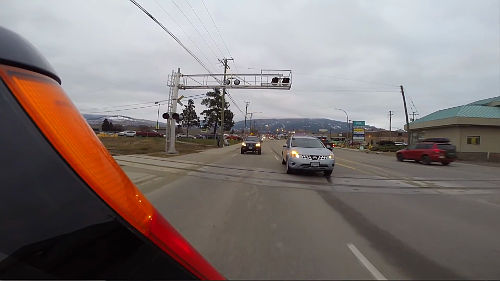
And, I'm just looking in the mirror, making sure that my GoPro is still there hanging on the side of the vehicle, because it's not my GoPro, it's somebody else's.
I do have a tether on it, but I borrowed it, a friend of mine let me use it, and I went out and bought the suction cup for the side of the vehicle.
And actually, it works really well, but since it's not mine, I have a tether on it, so that in case it comes undone.
Okay, and we have to clear the intersection. I did get caught out there.
Okay, right signal on, as soon as I get around the intersection.
Shoulder checking, shoulder check again as I'm moving over, okay signal off.
Conclusion
Quick review of lane changes, determining the gap, and doing it safely.
One of the key ingredients of changing lanes effectively, as you saw here in the video, is to signal effectively, three flashes minimum on the signal, before you start moving over.
And, head check, head check before you put your signal on, and a head check before you start moving over.
That is going to keep you safe, for the purposes of both the road test, and after you get your license, and you continue to change lanes.
And, you need to shoulder check, do not let that wane. As well, the other thing you can do, is go get those small convex mirrors, and put them on your existing mirrors, and that will help you to see into your blind spots.
And, check down in the description there, I'll put a link to those convex mirrors, those stick on convex mirrors that you can get, and those too will help you out if you have some mobility challenges, your head, and those types of things.
If you have challenges, those convex mirrors will help you out, as well, to lane change.
But, remember, driving is a social activity, and if we ask nicely, other people, most of the time, 98% of the time, are going to help you out, so just know that.
Question for my Smart Drivers:
Do you have difficulty changing lanes, because you weren't observing?
Leave a comment, down in the comment section there.

All of that helps of the new drivers working towards getting their license, and veteran drivers looking to improve his or her skills. If you like what you see here.
Share, subscribe, leave a comment, down in the comment section. As well, hit that thumbs up button.
Check out all the videos here on the channel if you're working towards a license, or starting a career as a truck or bus driver.
Head over to the Smart Drive Test website. As well, more great information over there, and online courses that you can purchase.
All of the courses are guaranteed, pass your road test first-time, 60 day money back guarantee. It's for both for new drivers, and CDL drivers.
Look down in the description there, and find the coupon for 30% off the "pass your road-test first-time."
And yes, it will teach you how to learn to pass your road test, and the information, skills, and abilities that you need, to be successful on passing your road test, first time.
I'm Rick, with Smart Drive Test, thanks very much for watching. Good luck on your road test, and remember:
Pick the best answer, not necessarily the right answer. Have a great day. Bye now.
[OUTRO, MUSIC & BLOOPER] Hi there Smart Drivers. Rick, with Smart Drive Test, talking to you today about...

